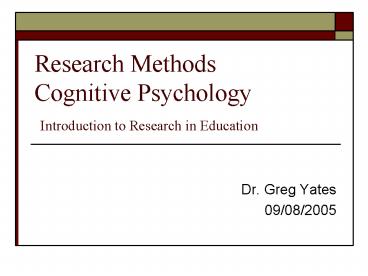Research Methods Cognitive Psychology Introduction to Research in Education - PowerPoint PPT Presentation
1 / 25
Title:
Research Methods Cognitive Psychology Introduction to Research in Education
Description:
They were taught using a video-tape from either an expert or a beginner in electronics. ... On errors made, beginner-instructed novices performed better than expert ... – PowerPoint PPT presentation
Number of Views:1766
Avg rating:3.0/5.0
Title: Research Methods Cognitive Psychology Introduction to Research in Education
1
Research MethodsCognitive Psychology
Introduction to Research in Education
- Dr. Greg Yates
- 09/08/2005
2
What is personalization?
- Answer Incoming information is self-relevant
- For example You need to have an ID card.
- Compare
- a) People must lodge forms by 1st of
January. - b) Your forms must be in by 1st of January.
3
Can personalization be used educationally?
- Answer Yes
- One way has been to introduce it into
multi-media lessons and simulations. - For example
- Your goals is to
- The instructions will guide you through
- What do you think will happen?
4
The cognitive theory of personalization(from
Mayer, Fennell, Farmer Campbell, 2004)
5
NEED for Experimental Data
6
Experimental Data No.1
- A Personalization Effect in Multimedia Learning
Students Learn Better When Words Are in
Conversational Style Rather Than Formal Style - Richard E. Mayer, Sherry Fennell,
- Lindsay Farmer, and Julie Campbell
- University of California, Santa Barbara
7
Mayer et al. (2004) used college students, your
age
- They worked in cubicles with head phones, and
given a short computer lesson on respiration,
then a test of memory retention, then a test of
knowledge transfer.
8
There are three phases in respiration inhaling,
the (your) diaphragm moves down creating more
space for the (your) lungs, air enters through
the (your) nose or mouth, moves down through the
(your) throat and bronchial tubes to tiny air
sacs in the (your) lungs. During exchange, oxygen
moves from the (your) air sacs to the bloodstream
to the (your) air sacs. During exhaling, the
(your) diaphragm moves up creating less room for
the (your) lungs, air travels through the (your)
bronchial tubes and throat to the (your) nose and
mouth ,where it leaves the (your) body.
9
Note
- Independent variable (treatment)
- The lesson was either personalized or
non-personalized (60 seconds) - Dependent variable
- Retention test (5 mins)
- Transfer test (12 mins)
10
The retention test sheet had the following
question printed at the top of the page Using
what you learned in the lesson, please write an
explanation of how the respiratory system works.
11
The five transfer test sheets each had one of the
following questions printed at the top of the
page
- Suppose you are a scientist trying to improve
the human respiratory system. How could you get
more oxygen into the bloodstream faster? - A researcher makes the claim that pollution
causes heart disease. Explain why this would be
true. - Not enough oxygen is getting to the brain, and a
person is about to faint. What could be wrong
with the respiratory system? - What mechanism in the body do you think allows
you to breathe unconsciously, as you do when you
are sleeping? - Please explain why oxygen transfers to the
bloodstream and carbon dioxide transfers to the
air sacs during the exchange phase of
respiration.
12
Scores on Retention and Transfer Tests for Two
Groups in Three Experiments
Note. Asterisks indicate that the personalized
group scored significantly higher than the
nonpersonalised group.
13
Does personalization affect transfer performance?
- The top two rows of Table show the mean scores
and standard deviations for the two groups in
Experiment 1 on retention and transfer. The mean
score on the retention test was not significantly
different for the two groups, t (60)lt1, ns,
yielding an effect size of -0.02. - The mean score on the transfer test was
significantly greater for the personalized group
than for the nonpersonalized group, t (60)2.170,
p .034, yielding an effect size of 0.65.
14
Scores on Retention and Transfer Tests for Two
Groups
15
The cognitive theory of personalization(from
Mayer, Fennell, Farmer Campbell, 2004)
16
Experimental Data No.2
- Bothered by Abstraction The Effect of Expertise
on Knowledge Transfer and Subsequent Novice
Performance - Pamela J. Hinds
- Michael Patterson
- Jeffrey Pfeffer
- Stanford University
17
Characteristics of Experts
- Expertise is domain-specific.
- Experts see meaningful patterns.
- Experts perform skills and solve problems
quickly. - Experts make effective use of short-term memory.
- Experts represent problems at a deep, conceptual
level. - Experts emphasize analyzing problems and planning
solutions. - Experts self-monitor.
18
Questions
- Can experts teach?
- Is it better to be taught by an expert, or by
someone not so expert?
19
Hinds et al. (2001) had students earn 10 for
learning how to construct an electrical circuit.
They were taught using a video-tape from either
an expert or a beginner in electronics. Students
were then tested for speed and accuracy and also
tested on a second task.
20
- Independent variables Expertise of your
teacher - Dependent Variables
- Direct Leaning
- Errors made
- Times to complete
- Applied knowledge
- Performance on a similar but
different task
21
Direct Learning
On completion time, beginner-instructed novices
performed better than expert-instructed novices,
F(2, 68) 21.78, plt.001. On errors made,
beginner-instructed novices performed better than
expert-instructed novices, F(2, 68) 15.39,
plt.001.
22
Applied Knowledge
The finding is that with an expert instructor
students were able to transfer the learning to a
second task more effectively. The effects size of
0.48 is seen quite strong.
23
(No Transcript)
24
Conclusions for today
- A beginner can still teach you a good deal.
- But an expert can teach you how to transfer the
skills. - You will remember more if you apply this
knowledge to yourself.
25
- Thank you !































